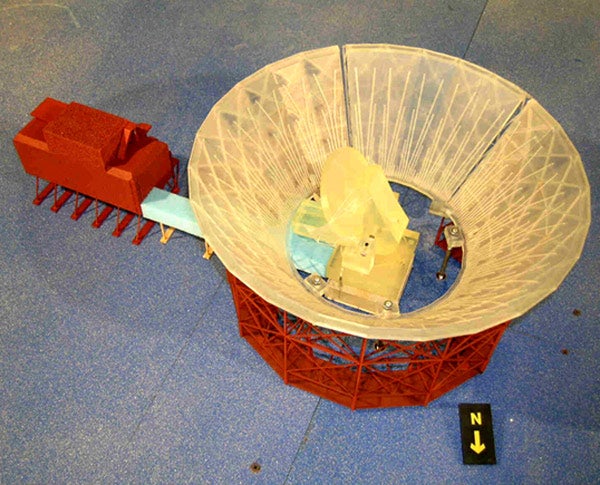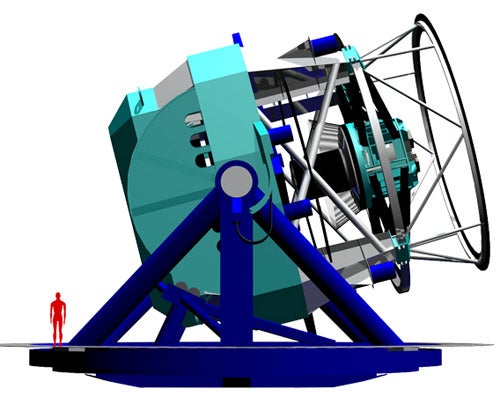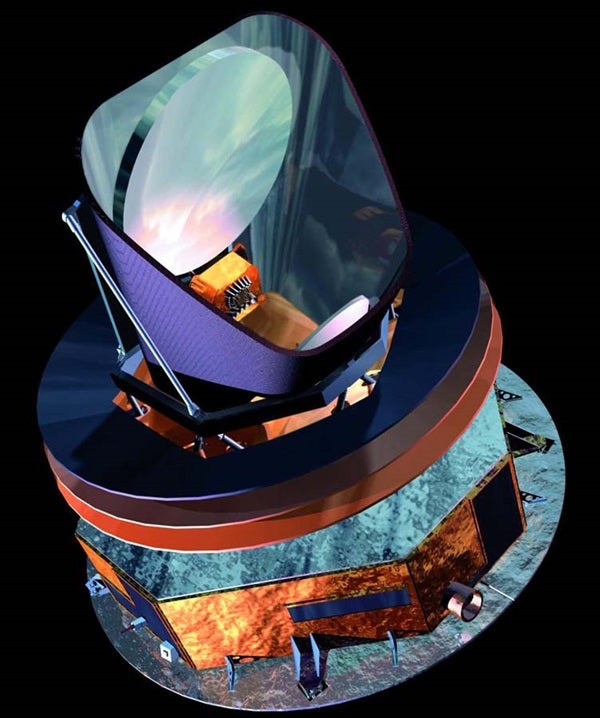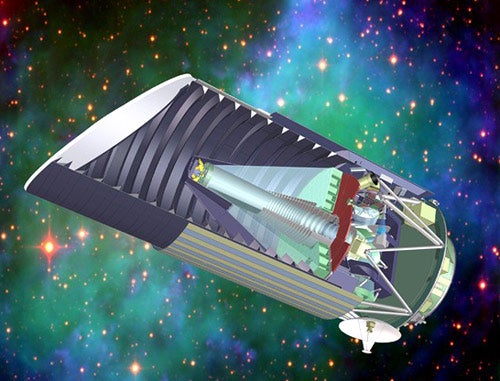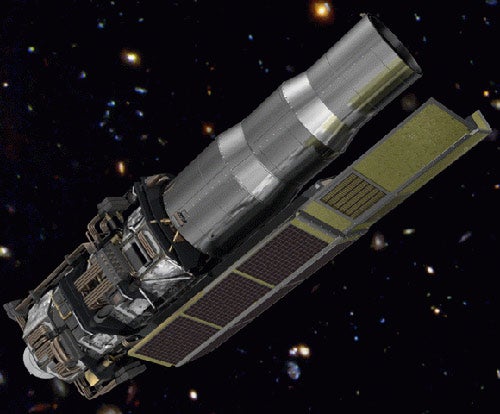Over the next decade, scientists will make observations to learn more about cosmology’s biggest mystery: the nature of dark energy. A slew of telescopes are in the planning or construction stages to aid in this effort.
South Pole Telescope (SPT)
SPT is currently under construction and expected to begin its survey in spring 2007. This will be a ground-based 10-meter telescope located at the National Science Foundation’s South Pole research station. The SPT will be sensitive to submillimeter wavelengths — between far-infrared and radio. By surveying galaxy clusters with SPT and determining their redshifts, scientists will learn how dark energy affects cosmic structure.
SPT is currently under construction and expected to begin its survey in spring 2007. This will be a ground-based 10-meter telescope located at the National Science Foundation’s South Pole research station. The SPT will be sensitive to submillimeter wavelengths — between far-infrared and radio. By surveying galaxy clusters with SPT and determining their redshifts, scientists will learn how dark energy affects cosmic structure.
Large Synoptic Survey Telescope (LSST)
Now that the site has been chosen, scientists expect LSST will begin taking data in 2012. It will be a ground-based 8.4-meter telescope located in northern Chile. As its name suggests, the LSST will be a large-scale survey, with a 10-square-degree field of view and the ability to observe the entire visible sky every 3 nights. Because it surveys the same area often, it will detect changes such as supernovae and near-Earth objects. The LSST’s main focus, however, is to study weak gravitational lensing to map the universe’s dark matter and give clues about dark energy. All data will be publicly available.
Now that the site has been chosen, scientists expect LSST will begin taking data in 2012. It will be a ground-based 8.4-meter telescope located in northern Chile. As its name suggests, the LSST will be a large-scale survey, with a 10-square-degree field of view and the ability to observe the entire visible sky every 3 nights. Because it surveys the same area often, it will detect changes such as supernovae and near-Earth objects. The LSST’s main focus, however, is to study weak gravitational lensing to map the universe’s dark matter and give clues about dark energy. All data will be publicly available.
Planck Surveyor
Unlike the other missions discussed here, the European Space Agency’s Planck Surveyor will observe the cosmic microwave background (CMB). It’s the third-generation CMB probe — the COsmic Background Explorer (COBE) was the first generation, and the Wilkinson Microwave Anisotropy Probe (WMAP) was the second. Planck, which will launch in spring 2007, will make the most detailed observations yet of the CMB and, with those data, further refine the universe’s parameters.
Unlike the other missions discussed here, the European Space Agency’s Planck Surveyor will observe the cosmic microwave background (CMB). It’s the third-generation CMB probe — the COsmic Background Explorer (COBE) was the first generation, and the Wilkinson Microwave Anisotropy Probe (WMAP) was the second. Planck, which will launch in spring 2007, will make the most detailed observations yet of the CMB and, with those data, further refine the universe’s parameters.
Joint Dark Energy Mission (JDEM)
NASA and the U.S. Department of Energy (DOE) teamed up to form JDEM. The collaboration has set a schedule to launch a dark-energy satellite. JDEM has solicited proposals to decide the satellite’s design. Currently, there are two front-runners: The Supernova Acceleration Probe (SNAP) and the Joint Efficient Dark-energy Investigation (JEDI). JDEM is expected to pick the winning team within 2 years. Once the satellite is launched, it will take data for 3 years.
NASA and the U.S. Department of Energy (DOE) teamed up to form JDEM. The collaboration has set a schedule to launch a dark-energy satellite. JDEM has solicited proposals to decide the satellite’s design. Currently, there are two front-runners: The Supernova Acceleration Probe (SNAP) and the Joint Efficient Dark-energy Investigation (JEDI). JDEM is expected to pick the winning team within 2 years. Once the satellite is launched, it will take data for 3 years.
- Supernova/Acceleration Probe (SNAP)
Because SNAP is a JDEM contender, it’s still in the planning stages. SNAP would measure thousands of supernovae over a range of distances to fill in the gaps that the Supernova Cosmology Project, High-Z Supernova Search, Hubble searches, and other projects have left open. The 2-meter space-based telescope also would map weak gravitational lensing. SNAP also would further refine the universe’s energy density and mass density.
- Joint Efficient Dark-energy Investigation (JEDI)
The JDEM contender JEDI would be a space-based 2-meter telescope. The satellite would study dark energy using three separate methods: type 1a supernovae, weak gravitational lensing, and baryon acoustic oscillations.


